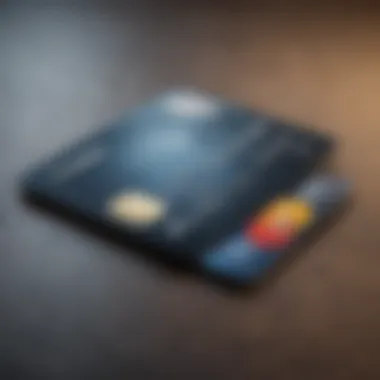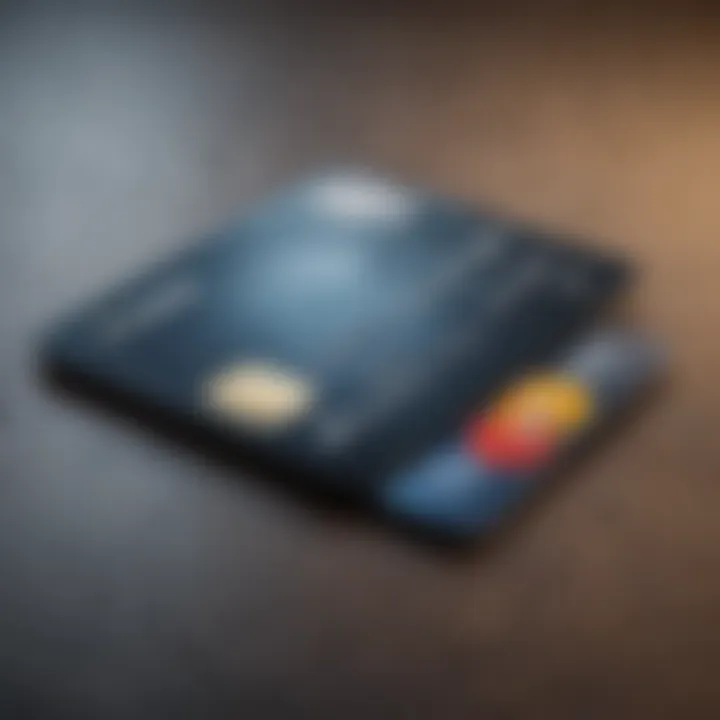Top Digital Credit Card Apps: Features and Comparisons


Intro
In today’s fast-paced financial landscape, digital credit card apps have emerged as indispensable tools for managing personal finances. With the rise of contactless payments and digital banking, these apps not only offer a convenient way to transact but also provide vital insights into spending habits. As users dive into this realm, they often find themselves weighing options from a myriad of available applications, each boasting unique features and functionalities.
This guide delves into the vast world of digital credit card applications, dissecting their fundamental characteristics, usability, and security. By navigating through the essential aspects of each app, our aim is to equip readers—whether beginners stepping into the digital finance sector or seasoned investors looking for streamlined solutions—to make educated decisions that cater to their financial aspirations.
To sharpen our focus, we will highlight crucial investment terminology relevant to the digital payments world, providing definitions and insights that can ease the understanding of the apps' features.
"Understanding the tools at your disposal is the first step to financial empowerment."
Moreover, we will explore expert perspectives, offering strategies and tips for optimizing the use of these apps, ensuring not just efficiency but also security in financial management. With an eye toward particular strengths and possible shortcomings, this guide will serve as a compass for navigating the innovative advancements in personal finance today.
Let’s dive into the Investment Terminology that will serve as the foundation of our exploration into digital credit card apps.
Preamble to Digital Credit Card Apps
In today’s fast-paced financial landscape, digital credit card apps have emerged as a mainstay for both consumers and businesses alike. Their significance goes beyond mere convenience; they fundamentally transform the way money is spent, tracked, and managed. With the explosion of mobile technology, managing finances has never been easier, and these apps sit at the heart of this evolution.
Digital credit card apps are like having a personal banker right in your pocket. They cater to a plethora of users, from the novice who is just starting out in the world of credit to the seasoned investor who needs to manage multiple accounts efficiently. The importance of these tools can be boiled down into a few key elements that make them indispensable in modern finance.
First and foremost, usability is a critical benefit of digital credit card apps. Most of them provide user-friendly interfaces that allow users to navigate without needing an advanced degree in finance. This ease of access ensures that anyone can track their expenses, analyze spending habits, and even learn to budget better—all from a handheld device. Many apps allow users to categorize their expenses, providing visual aids like charts and graphs. This democratization of financial literacy is exceptionally beneficial for first-time users who may otherwise feel overwhelmed.
Another critical aspect to consider is the increased security these apps provide compared to traditional credit card systems. Encryption techniques safeguard personal information against potential fraud, giving consumers peace of mind as they conduct transactions. For many users, the fear of credit card theft is a huge hurdle in exploring digital payments. Knowing that these apps often incorporate cutting-edge security measures helps alleviate those concerns.
Moreover, the real-time data tracking and notifications that apps provide can be game-changing. Users receive instant updates on spending, alerting them to unusual transactions or even nudging them to stick to their budgets. This immediate feedback can be incredibly powerful in promoting more responsible financial behaviors.
"Modern finance is not just about numbers; it's about understanding your habits and choices. Digital credit card apps put that understanding within reach."
Finally, it’s worth mentioning that these tools are not simply standalone solutions. Many of them seamlessly integrate with other financial management systems, enhancing their overall utility. Whether one is managing investments through an app like Robinhood or overseeing bills through utilities like Mint, having a cohesive system ensures better financial health and more informed decision-making.
Thus, as we delve deeper into digital credit card apps in the sections that follow, it’s crucial to appreciate their significance. They are reshaping how we view and handle money, breaking down barriers, and offering tools that were previously available only to a select few. Understanding their functionality, benefits, and potential pitfalls will empower users to make informed choices tailored to their individual needs.
What is a Digital Credit Card App?
In the realm of personal finance, digital credit card apps are transforming how individuals manage their spending and payments. Understanding what these apps encompass is crucial for anyone looking to streamline their financial transactions, adapt to technological trends, and maximize their resources. As these applications continue to evolve, they offer a blend of convenience and control that their traditional counterparts often lack, marking a significant milestone in the digitization of finance.
Definition and Functionality
Digital credit card apps are mobile applications that enable users to manage their credit card activities right from their smartphones. These apps provide core functionalities such as viewing balances, making payments, and monitoring transactions. Users typically sign up by connecting their existing credit cards, and from there, the app takes over with a user-friendly interface. This makes tracking expenses a walk in the park compared with the old school of jotting down expenditures in a ledger.
The main perks of using these apps involve not just the straightforward monitoring of transactions but also real-time alerts. For example, a user might receive notifications after a purchase, helping to prevent fraudulent activities immediately. Moreover, some apps include budgeting tools and expense categorization features, allowing users to see where their money is going at a glance.
To illustrate, consider the experience of a user who, after linking their card to an app, gets insights into their monthly spending patterns. They might discover they've been overspending on dining out. This immediate feedback can lead to better budgeting decisions moving forward. It’s akin to having a financial mentor in your pocket.
Evolution of Digital Payments
As we peer into the evolution of digital payments, it becomes evident that consumer habits have been influenced by numerous factors, including technological advancements and the demand for convenience. The shift toward digital credit card apps reflects broader trends, such as the rise of e-commerce and the proliferation of smart devices. In the early days of online transactions, security concerns and clunky interfaces often hindered user adoption. Fast forward to today, and a well-designed app can provide a seamless, secure experience that feels second nature.
The timeline of this evolution is rich. The introduction of mobile wallets, for example, paved the way for digital credit cards, allowing users to store card information securely in their devices. This innovation removed the friction of pulling out physical cards, making purchases faster and often safer, thanks to advanced encryption and biometric security measures.
Now, with the likes of Apple Pay and Google Pay leading the charge, the demand is shifting towards all-in-one platforms that offer not just payment handling but also comprehensive financial management. It’s no longer a simple transaction; it’s about integrating all aspects of personal finance into one streamlined app.
Digital credit card apps serve as the backbone of modern financial interactions, redefining how we think about money, access, and security.
As these apps progress, they remain essential to our financial toolkit, catering to users' needs for efficiency and organization in an increasingly digital world. Understanding this landscape better allows users to make educated decisions, optimizing their financial management approaches as they navigate this bright new frontier.
Benefits of Using Digital Credit Card Apps
In the ever-evolving landscape of finance, digital credit card apps have carved out a substantial niche. They tweak how we manage our money, intertwining convenience with advanced technology. Understanding the benefits of these apps isn't merely a nice-to-have; it's essential for anyone looking to brush up their financial savvy. These applications aren't just flashy gadgets in our wallets; they offer real, substantial gains that resonate with both newcomers and seasoned investors.
Enhanced Security Features
When it comes to handling finances, security is the name of the game. Digital credit card apps come packed with a slew of advanced security features, aiming to fortify user data against the lurking threats of fraud and hacking. Most major players, like Venmo and Chime, deploy data encryption techniques that ensure sensitive information remains under wraps.
Two-factor authentication has become a popular safety net employed by these apps. This means that accessing your account requires more than just a password. This extra layer is akin to adding a deadbolt on your front door. Users feel secure, which is critical since the online world can often feel like walking a tightrope without a safety net.


"A strong password is like a strong lock; it keeps the bad guys out."
Moreover, the ability to freeze or unfreeze your card within the app can swiftly mitigate any potential fallout from unauthorized transactions. Users can take immediate action rather than waiting for customer service during regular business hours.
Real-Time Spending Tracking
Gone are the days of waiting for monthly statements to catch a glimpse of your spending habits. Digital credit card apps offer real-time tracking, allowing users to see, at a glance, where their hard-earned money is going. This is an indispensable feature, particularly in a world where impulse purchases can derail even the best-laid budgets.
Users can categorize their expenses into buckets—dining out, groceries, entertainment. You can even set budgets for these categories. But do mind, not all apps offer this level of granularity; it's crucial to pick one that aligns with your personal budgeting style. Continuous insights promote awareness, discouraging reckless spending as users become acutely aware of each outgoing dollar. Plus, this feature makes it easier to identify wasteful habits that you can easily shake off.
Convenience and Ease of Use
One of the key selling points of digital credit card apps is their unparalleled convenience. You can access your finances while standing in line at a coffee shop. The apps are designed with user experience in mind—streamlined interfaces, easy navigation, and intuitive features together create a harmonious experience.
From scanning to pay, to sending money to a friend, the capabilities are vast and varied—often found in the palm of your hand within moments. Customers no longer have to juggle multiple cards or sift through receipts. Everything you need is neatly condensed into one app, which saves not just time but also mental energy.
In an age where multitasking is the norm, being able to manage finances through an app while on the go is nothing short of revolutionary. While digital finance tools are becoming more prevalent, choosing the one that speaks to your needs can make all the difference in your financial management journey.
In summary, the benefits of using digital credit card apps extend well beyond basic transactions. Enhanced security measures provide peace of mind, real-time spending tracking empowers users to stay in control, and convenience makes financial management as easy as a swift thumb swipe. As these apps continue to evolve, they may just become the cornerstone of personal finance for many.
Key Features to Consider
When diving into the world of digital credit card apps, it becomes increasingly clear that not all apps are cut from the same cloth. Choosing the right app can feel like finding a needle in a haystack, but being aware of key features can streamline the process significantly. This section will dissect the essential elements that compel a user to choose one app over another, focusing on the interface, financial tool integration, and reward programs offerings. With the right knowledge in hand, users can make informed decisions that cater to their financial needs effectively.
User Interface and Experience
User interface (UI) and experience (UX) are arguably the first impressions one has with an app. An intuitive UI can make navigating financial information as easy as pie, while a complicated layout can feel like wading through molasses. Simplicity and clarity are often paramount; they can mean the difference between making a transaction smoothly or fumbling with functions in frustration.
A well-designed app should feature seamless navigation that allows users to quickly access their accounts, transaction histories, and other vital financial tools. Look for apps that offer customizable dashboards, enabling you to highlight the info that matters most to you. Moreover, consider the app's aesthetic—an appealing design can add to user satisfaction.
"In finance, as in life, clarity is king. The cleaner the app feels, the more confidence it breeds."
Integration with Financial Tools
The world of personal finance thrives on integration. A digital credit card app that syncs well with existing financial instruments can provide a fuller picture of one's financial health. Look for apps that facilitate easy linking with budget tracking tools, bank accounts, and even investment platforms. This interconnectedness allows users to have all their financial information consolidated in one place, reducing the need to hop between different apps like a frog on a hot plate.
When assessing integration capabilities, also keep an eye out for compatibility with emerging financial tech and APIs. Modern integrations could provide insights beyond basic spending habits, placing you in the driver’s seat of your financial journey.
Rewards Programs and Incentives
Many users seek out digital credit cards primarily for the perks. Rewards programs can come in various forms—cash back, points redeemable for travel, discounts on future purchases, or even exclusive offers at certain retailers. A thorough understanding of each app's rewards offerings will allow users to optimize their spending, ensuring that they're not just swiping for the sake of it.
When exploring rewards programs, consider how easily the points are accumulated and redeemed. Some apps may lure you in with flashy promises but deliver to the real world are more tedious than a snail race. Focus on programs that align with your spending habits. If you travel frequently, find apps that provide travel-related perks; if dining out more captures your interest, see if the app partners with local eateries.
In summary, understanding the key features of a digital credit card app is crucial for making an educated decision. From an inviting user interface to solid financial tool integration and valuable rewards, these components pave the way for a satisfactory user experience.
Security Considerations
In the world of digital credit card apps, security isn’t just an add-on feature; it’s the backbone of trust between users and providers. Users expect their financial data to be protected with robust measures, especially given the rise in cyber threats and financial fraud. A lapse in security could mean not only the loss of funds but also the compromise of personal information. Therefore, it’s vital for users to thoroughly evaluate the security features offered by any app they consider. This section delves into significant elements such as data encryption techniques and fraud prevention measures associated with digital credit card apps.
Data Encryption Techniques
Data encryption serves as the first line of defense for information transmitted between a user’s device and the server of their chosen credit card app. Think of encryption as a type of code language that only the intended recipient can decipher. In layman's terms, it transforms make-sensitive data into a jumble of characters, rendering it unreadable to any eavesdroppers.
Most reputable apps utilize Advanced Encryption Standard (AES) with a 256-bit key length, which is considered very secure. This standard is often employed in both government and financial institutions. However, not all encryption methods are created equal. Users should inquire about details of the protocols used by their chosen app because weak or outdated encryption methods can leave doors ajar for hackers and malicious entities.
Several apps also employ multiple levels of encryption, protecting data both at rest on servers and in transit between devices. This ensures comprehensive coverage, mitigating risks from various angles.
"In an age where data breaches comprise a substantial 36% of all fraud attempts, encrypting sensitive data is no longer optional—it's imperative."
Fraud Prevention Measures
Even the most reliable encryption can’t guarantee absolute protection against every type of financial fraud. That’s why strong fraud prevention measures are essential in any digital credit card app. Users should look for features such as multi-factor authentication (MFA), transaction alerts, and odd activity detection algorithms.
MFA adds a level of scrutiny when logging in or making purchases. Instead of just a username and password, users might receive a code via text or email that they have to input—making it considerably more difficult for a fraudster to access an account.


Transaction alerts promptly notify users of any transactions made using their account, allowing them to quickly flag any suspicious activity. This feature acts as an onion, with layers of security providing a robust defense against potential fraud.
Odd activity detection uses advanced algorithms to track usage patterns. If the app detects unusual spending patterns, it may immediately freeze the account and notify the user, offering an extra layer of defense against potential breaches.
In short, evaluating the security features of digital credit card apps is crucial for a safe financial experience. Users must prioritize both data encryption and fraud prevention techniques, as these are the bedrock elements that protect their hard-earned money.
Overview of Popular Digital Credit Card Apps
In today’s fast-paced financial world, digital credit card apps have rapidly become essential tools for managing money. The significance of this topic punches you right in the face if you think about how these applications can influence your financial life. The landscape is filled with choices, each one boasting varying features, security measures, and user experiences. To make sense of it all, a deep dive into the realm of popular digital credit card apps is not just useful but necessary.
Digital credit card apps simplify the way we deal with finances, merging the need for convenience with advanced technology. When analyzing popular apps, several elements should be front and center: the user experience, the available features, customer service, and any fees associated with usage. Understanding these factors can be a game changer for anyone from beginner investors to seasoned financial enthusiasts.
Recognizing the variations in features among these apps plays a crucial role in identifying which option best aligns with your personal financial goals. You might prioritize user-friendly interfaces or seek out apps that provide robust budgeting tools alongside your digital card. Then there's the aspect of security. Some apps have layers of protection that feel nearly bulletproof, while others may leave you feeling a tad exposed.
Overall, this section sets the stage for a detailed comparison, emphasizing usability and security—aspects you can't afford to overlook when choosing which app will serve your financial needs best.
Detailed Comparison of Features
When it comes down to selecting a digital credit card app, the detailed comparison of features serves as the backbone of your decision-making process. Each app comes stocked with unique functionalities that cater to different financial management needs.
Take, for example, the cash-back incentives that some apps offer – a great perk if you consistently make purchases across various categories. Conversely, others might excel in budgeting capabilities, providing visual graphs to help you keep tabs on your spending in real time. Here are a few elements worth noting:
- User-Friendly Dashboard: The ease of navigation is critical. Users should feel comfortable skimming through their expenses without feeling lost or overwhelmed.
- Analytics Tools: Some applications provide advanced analytics that reveal spending habits over time, allowing you to adjust your financial behaviors.
- Integration with Other Financial Tools: Compatibility with budgeting or financial planning apps splits the field between basic and advanced functionality.
- Flexibility in Usage: Being able to link various accounts or handle multiple transactions seamlessly can be a dealmaker.
Each of these features adds layers to the app's overall appeal and functionality, making it indispensable to compare them directly.
Market Leaders and Innovative Startups
The digital credit card app marketplace is a melting pot of well-established players and daring startups that disrupt traditional finance. It’s crucial to shine a light on both sides to get a full view of the field.
Market leaders such as Chase and American Express have paved the way with robust security and a plethora of features that meld convenience and user engagement. They tend to be reliable but may also come with hefty fees for some of their features.
On the flip side, there are innovative startups like N26 or Chime, offering fresh interfaces and aggressive incentives to attract users. Their growth speaks volumes about consumer preference shifting towards flexibility, lower fees, and tech-savviness. Startups often embrace new technologies, such as blockchain or advanced security protocols, which not only enhance the user experience but also build trust with a more tech-savvy audience.
It's essential to recognize how both market leaders and fresh contenders contribute to the ever-evolving landscape of digital credit card apps. Evaluating both kinds against your specific needs will lead to a choice that aligns perfectly with your financial journey.
User Reviews and Experiences
In the world of digital credit card apps, user reviews and experiences serve as a compass, guiding potential users through the vast sea of choices. These firsthand accounts not only echo the effectiveness of an app but also reveal user sentiment, which can influence one's decision significantly. Understanding the nuances of these reviews provides insight into what works and what doesn't, helping users make more informed choices that align with their financial goals.
Evaluating user feedback involves not just the ratings but also the stories behind them. Successful experiences can highlight an app’s strengths, while critiques can bring attention to areas needing improvement. For instance, if multiple users mention that a certain app is user-friendly but also report a common glitch, potential adopters can weigh the pros against the cons.
Moreover, user reviews create a sense of community. They invite conversations around features, opportunities for improvement, and overall experiences. When personal finances are involved, seeking counsel from those who have already navigated these waters can be invaluable. Reviews and experiences lay bare the promises and pitfalls of each app. They are a testament to the ever-changing landscape of digital finance.
Positive Feedback and Success Stories
Positive feedback is often the loudest voice in the crowd, resonating through stories of success and satisfaction. Users frequently relay tales of how a particular digital credit card app enabled them to gain better control over their spending habits or how they capitalized on rewards programs that improved their overall financial health.
Most commendable are stories about interactions with customer service. A user might recount how a helpful representative walked them through a complicated process or helped resolve an account issue in a timely manner. Such experiences often stand out and keep customers coming back to the app, as they feel valued and supported.
“I never kept track of my spending until I started using the AppName. Now, I'm saving more and spending less – it’s a game-changer for me!”
— A satisfied user
Another aspect is how these apps contribute to users’ financial literacy. As features like budgeting tools and spending alerts become integrated, users often share how these functions have helped them make better financial decisions, fostering a more conscientious mindset toward their spending.
Common Challenges and Criticisms
On the flip side, many users voice challenges that arise when using digital credit card apps. A frequent criticism relates to technical issues. Users often report glitches such as transaction failures or app crashes that hinder their financial management efforts. These complaints serve as a reminder that despite advancements, technology is often imperfect.
Additionally, some users find their needs aren’t met because an app may lack essential features or flexibility. For example, if an app doesn’t support multiple currencies or doesn’t provide a seamless experience when switching between devices, it can lead to frustration.
User reviews often touch upon concerns about privacy and data security, which hold significant weight in the financial technology landscape. People are rightly skeptical about how their data is handled, and many reviews highlight withdrawals from certain apps due to fears of potential breaches or misuse of personal information.
Lastly, fees can become a thorny issue. Many reviewers share dissatisfaction regarding unexpected fees that seem to pop up without adequate prior notice. This can lead to distrust and a shift toward competitors perceived as more transparent in their dealings.
By analyzing both the highs and the lows of user reviews and experiences, potential users can navigate their way to the right digital credit card app that fits their unique circumstances, ensuring a better match for their individual needs.


Future Trends in Digital Credit Card Apps
As we peer into the future of digital credit card apps, a range of trends emerges that promise to significantly reshape the way we manage our finances. The importance of understanding these trends lies in their potential impact on user experience, security, and overall functionality. With a fast-evolving technological landscape, staying ahead of the curve offers numerous benefits for seasoned investors as well as those new to digital finance.
Technological Advancements on the Horizon
Digital credit card apps are on the verge of transformation driven by technological advancements. These innovations are not just theoretical; they are increasingly practical and becoming integral in consumer financial lives.
- Artificial Intelligence and Machine Learning: These tools are poised to enhance personalization in financial management. For instance, AI can analyze a user's spending habits and suggest adjustments to budgets or alert them about potential savings. This shifts the focus from merely tracking expenses to actively managing and optimizing them.
- Blockchain Technology: An often-discussed topic in the realm of finance, blockchain has significant implications for digital credit card transactions. It could offer enhanced security measures, reducing fraud and ensuring that transactions are verified in real-time. The transparency provided by blockchain can also build trust between users and financial institutions.
- Augmented Reality Integration: Although it may seem like something out of a sci-fi movie, augmenting our physical world with digital finance capabilities could soon be a norm. Imagine walking into a store and seeing product prices alongside your available credit or promotional offers tailored to your spending habits, all displayed through your smartphone's camera. This not only enhances the shopping experience but also provides immediate insights into finances.
Impact of Regulation and Compliance
The landscape of digital credit card apps doesn’t only revolve around technology. Regulation and compliance play a critical role in shaping how these apps will operate. As user adoption grows, so does the scrutiny from regulatory bodies. Here are several key points regarding this future impact:
- Stricter Data Protection Laws: As privacy becomes a larger concern for consumers, regulations such as the General Data Protection Regulation (GDPR) in Europe and California Consumer Privacy Act (CCPA) in the US may be enacted globally. Apps may need to enhance their data protection protocols, which can influence their operational frameworks and user trust.
- Increased Oversight of Financial Transactions: Governments are likely to impose stricter oversight on financial transactions to curb money laundering and protect consumers from frauds. This means that these digital credit card apps must ensure robust compliance mechanisms are in place, which could lead to additional operational costs but also ensure customer safety.
- Consumer Education Initiatives: To navigate the shifting regulatory landscape, digital credit card apps may introduce educational content for their users. This can help users navigate compliance requirements effectively, understand their rights regarding financial transactions, and foster a more informed user base.
As the financial world is transitioning rapidly, the integration of technological advancements and regulatory compliance remains pivotal in defining the future of digital credit card apps. Understanding these aspects not only empowers users but also shapes investment strategies, making it an essential topic for those keen on financial technologies.
The interplay between technology and regulation will determine the trajectory of digital credit card apps, creating both challenges and opportunities for users.
How to Choose the Right App for Your Needs
Choosing the best digital credit card app is crucial in navigating through the vast sea of financial technology available today. Each app offers different features and focuses, making it essential to know your own requirements before making a decision. This section aims to help you align your unique financial situation with the right tool. Keeping in mind that your financial health is priority number one, a careful assessment can lead you to an app that fits like a glove.
Assessing Personal Financial Goals
Before even thinking about downloading an app, it's wise to sit down and jot down your financial goals. Are you keen on tracking expenses? Or perhaps you're more interested in maximizing rewards? Your goals can dictate the type of features you should focus on in the app you choose. For example, if budgeting is your main concern, you may want an app that provides comprehensive tracking of spending habits. Conversely, if rewards are at the forefront of your objectives, look for apps that offer robust rewards earning structures and easy points redemption.
Some other key points to consider include:
- Current Financial Situation: What are your income, expenses, and debts like? Understanding your financial standing can help outline your goals better.
- Future Financial Aspirations: Are you saving for a big purchase? Maybe planning for your child’s education? Knowing your long-term goals will guide app selection.
- User Experience: How comfortable are you with technology? Some apps come with a steep learning curve. Choose one that matches your tech-savviness.
By doing some groundwork on these aspects, you will be setting the stage to make a more informed choice down the line.
Trial and Error: Testing Apps
Once you have a clear view of your objectives, it’s time to dip your toes in before taking the plunge. The world of digital credit card apps allows ample opportunity for testing. Most apps offer a free trial period, letting users explore features without the immediate pressure of commitment.
Here’s a step-by-step approach on how to effectively test these apps:
- Create a List: Make a list of potential apps that pique your interest based on your financial goals.
- Download and Sign Up: Try downloading several apps to see which interface feels right.
- Explore Features: Spend time navigating through their features, functions, and any unique offerings.
- Evaluate Usability: Is the app easy to navigate? Can you find information with minimal hassle?
- Feedback Loop: Consider keeping a notebook to track your impressions and any challenges faced, assisting you in evaluating each options effectively.
"The best way to find out what works for you is to give things a whirl. You won't know what's a good fit without trying it out!"
In closing, committing to the right digital credit card app requires an understanding of your financial habits and goals. The journey doesn't need to be a sprint; take your time navigating through your options until you land on the one that checks all the boxes for you.
End: The Role of Digital Credit Card Apps in Modern Finance
As we step into an era where everything is interconnected, digital credit card apps have made their mark on personal finance. These tools are not just about convenience; they're shaping the way individuals manage their money. The significance of these applications goes beyond the traditional understanding of credit cards.
Financial Empowerment
Digital credit card apps provide users with a level of empowerment that was previously unattainable. For many, the ability to track spending in real-time shifts the emphasis from simply spending to being conscious of financial choices. Oftentimes, people find themselves in a cycle of overspending because they lack tools to understand their habits. With these apps, users are able to analyze their transactions, getting a clear picture of where their money is going. This data-driven approach aids in budgeting and helps individuals to set realistic financial goals.
Enhanced Security and Privacy
Another aspect worth noting is the security features embedded within these applications. Enhanced data encryption and other sophisticated fraud prevention measures reassure users that their sensitive information is well-guarded. In a world where data breaches are common, the importance of security can’t be overstated. Users can feel more confident making transactions, as their financial information is less vulnerable to unauthorized access. This aspect is crucial, especially for younger generations who are more inclined to conduct their financial activities online.
Adaptation to Evolving Consumer Habits
Digital credit card apps also reflect the evolving habits and expectations of consumers. As more people lean on technology for daily transactions, the demand for usability grows. These apps are designed to meet that demand through user-friendly interfaces and seamless integration with other financial tools. This progress leads to a smoother experience for users, allowing for easier navigation and access to features that enhance their financial management.
Considerations for Future Development
While the benefits are aplenty, it's essential to consider potential pitfalls as well. As these applications thrive, regulatory scrutiny will likely increase. This means that developers must strike a balance between innovation and compliance. The future landscape may witness further advancements in technology, such as artificial intelligence, which could personalize user experiences even more. However, the need for transparency and user rights must remain at the forefront.
In summation, digital credit card apps are not merely a trend; they are a pivotal development in the field of personal finance. They empower users, enhance security, and adapt to changing consumer behavior. Navigating these waters with an informed perspective will enable users to leverage these tools effectively, fostering better financial health in the long run.
"In these days of financial uncertainty, knowledge and the right tools are your strongest allies."
The journey through the world of digital finance is just beginning, and the role of these apps will only grow in significance. Engaging with them thoughtfully will make all the difference.















